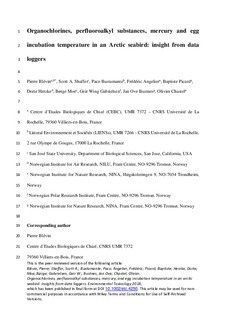| dc.description.abstract | In birds, incubation‐related behaviors and brood patch formation are influenced by hormonal regulation such as prolactin secretion. Brood patch provides efficient heat transfer between the incubating parent and the developing embryo in the egg. Importantly, several environmental contaminants are already known to have adverse effects on avian reproduction. However, relatively little is known about the effect of contaminants on incubation temperature (Tinc) in wild birds. By using temperature thermistors placed into artificial eggs, we investigated whether the most contaminated parent birds are less able to provide appropriate egg warming and thus less committed to incubating their clutch. Specifically, we investigated the relationships among 3 groups of contaminants (organochlorines, perfluoroalkyl substances [PFASs], and mercury [Hg]) with Tinc and also with prolactin concentrations and brood patch size in incubating Arctic black‐legged kittiwakes (Rissa tridactyla). Our results reveal that among the organochlorines considered, only blood levels of oxychlordane, the main metabolite of chlordane, a banned pesticide, were negatively related to the minimum incubation temperature in male kittiwakes. Levels of PFASs and Hg were unrelated to Tinc in kittiwakes. Moreover, our study suggests a possible underlying mechanism: since we reported a significant and negative association between blood oxychlordane concentrations and the size of the brood patch in males. Finally, this reduced Tinc in the most oxychlordane‐contaminated kittiwakes was associated with a lower egg hatching probability. | nb_NO |
